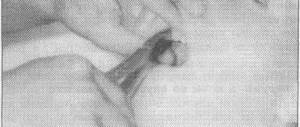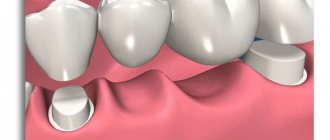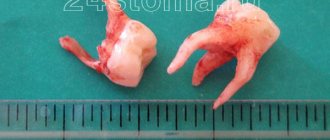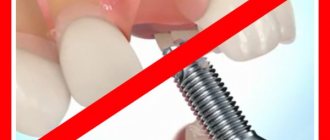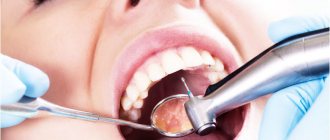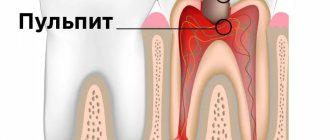Dental restoration or dental restoration is an artistic, direct and aesthetic restoration of the front teeth. Price for dental restoration in Moscow.
Each of us sooner or later faces a situation where teeth lose their aesthetic appeal. This may be due to carious tissue damage or deterioration in the quality of the old filling. In this case, dental units are completely or partially destroyed, their shape changes, and functionality deteriorates. As a result, a person loses one of the most important advantages - the ability to smile beautifully and communicate naturally with the interlocutor.
Today, the only correct solution is dental restoration. This procedure allows you to restore the functional characteristics and shape of damaged teeth using veneers or light-composite fillings.
Today, along with the term “artistic restoration of teeth,” consonant concepts (aesthetic and cosmetic restorations) are often found. However, in practice, they all have the same application and help restore the aesthetics of a damaged tooth.
In our Elident clinic, dental restoration is carried out by highly qualified specialists who master all the intricacies of this process, have the appropriate qualifications and solid experience. We carry out work of any complexity. Even if you need artistic restoration of your front teeth, you can count on an ideal result. Professional knowledge of all stages of dental restoration, an individual approach to each patient, the ability to work with modern materials and a flexible pricing policy - all this makes our services indispensable for patients and increases the chances of a successful outcome of the treatment process.
In this article we will talk about what aesthetic dental restoration is, consider the main methods and stages of its implementation, and provide detailed information on how much dental restoration costs in modern clinics in Moscow.
Free consultation
Our specialists will conduct a free consultation and select the best treatment option for you.
Sign up now! Online registration
+7 (495) 649-41-19
Content
hide
1 What methods of dental restoration exist?
2 Stages of dental restoration
3 Dental restoration before and after photos
4 What influences the price of tooth restoration? 4.1 Complete crown correction
4.2 If half a tooth needs to be restored
4.3 Restoration of a chipped cutting edge of a front tooth
5 What are the disadvantages of artistic dental restoration?
6 Alternative to composite restoration
7 Prices for dental restoration
Advantages and disadvantages of dental reconstruction with composite materials
Dental restoration with composite materials, like any method in dentistry, has its advantages and disadvantages. Let's look at them in detail.
Modern composite restoration has the following advantages:
- performing restoration work without grinding the tissues of adjacent elements (unlike the process of installing ceramic mini-prostheses);
- there is no need to perform a depulpation procedure;
- minimum time spent on restoration of one tooth;
- low price.
There are also some disadvantages:
- shorter service life than ceramic prosthetic products, both in terms of strength and aesthetic indicators;
- the possibility of secondary caries due to leaky adhesion of composite materials to dental tissues.
Despite some disadvantages, dental restoration with composites, if indicated, is a worthy alternative to standard and micro prosthetics.
What methods of dental restoration exist?
Currently, artistic restoration of teeth is carried out using the following two methods:
- Direct dental restoration : carried out using light-curing fillings. Dental restoration using composite materials, which is carried out by a specialist in therapeutic dentistry;
- Dental restoration with veneers : This procedure involves a prosthetic specialist who prepares the tooth and makes an impression. Next, the process of creating the veneer itself is carried out, which involves the use of ceramic or zirconium material. The resulting plate is glued to the outer surface of the tooth. As a rule, veneers are used when restoration of the front teeth takes place. Despite their inflated cost, they have a number of advantages.
Restoration of anterior teeth
We need the front teeth for normal chewing no less than the side teeth. If you have one or more of your front teeth destroyed, it will be difficult for you to bite off a piece of a green apple or crack a cracker.
However, the restoration of front teeth is of particular importance for a person’s social comfort. Therefore, in good clinics, aesthetic restoration of anterior teeth and their treatment are inseparable processes.
There are two restoration methods:
- Direct – involves modeling and restoring teeth directly in the patient’s mouth. In this case, composite materials are used - photopolymers and glass ionomers.
- Indirect (orthopedic) – an impression of the patient’s jaw is made. Then, structures from ceramic, zirconium or other materials are modeled and manufactured in the laboratory. In this way, it is possible to restore an almost completely lost tooth, but this already relates to the field of prosthetics.
Restoration of anterior teeth is performed using both methods. Each of them has its own advantages, disadvantages and areas of application.
The doctor decides which method will be used for you personally, based on the individual situation and the problems that the procedure should solve.
Stages of dental restoration
Next, we will talk in detail about how aesthetic restoration of anterior teeth is performed. An example will be a situation where a patient needs to restore a front tooth with old fillings that have lost their aesthetic appeal.
So, the restoration of the front teeth includes the following sequential stages:
- Preparing teeth. At this stage, dental units are cleaned of plaque, the shade of the destroyed tooth is determined and, based on it, the color of the photopolymer filling is selected.
- Administration of anesthetics (if necessary).
- Removal of tissues affected by caries . When there is a need to replace an old filling material that has lost its aesthetic qualities, it is drilled out.
- Elimination of excessive salivation . If previously cotton swabs were used for this purpose, now they use an innovative product - cofferdam. This is a material made of latex, which has special holes for teeth. Thanks to such a latex scarf, it is possible to qualitatively isolate the oral cavity from wet breath and saliva, which ensures a more reliable process for installing photopolymer fillings. If insulated incorrectly, dental restorations made with light-curing materials can quickly lose their properties. This will create an unwanted dark line between the tooth and the filling, or cause the composite material to fall out.
- Installation of the pin . It is used if there is massive destruction of the crown and there is no nerve in the tooth itself. In this case, tooth restoration is carried out on a pin, which plays the role of a strengthening element and prevents the restoration from falling out.
- Dental restoration with composite material . In order to give the tooth a natural appearance, a special technique for applying photopolymer mass is used. For this purpose, the light-curing material is applied in layers. It is thanks to the presence of layers with varying degrees of transparency and different color tones that it is possible to obtain a natural tooth shade.
- The final stage . The final processing of the dental unit is carried out, which includes grinding and polishing the filling material.
Dental restoration with composite materials
Tooth restoration using composite materials is a direct restoration method.
This means that dentists perform dental restoration work directly in the patient’s mouth, just as when installing a filling. This method assumes that the material used is a composite. It is a high molecular weight chemical compound called a polymer. The basis is the polymerization reaction of the starting substances, i.e. sequential combination of low molecular weight compounds (monomers) into large ones - polymers. In dental practice, composite materials are a synthesis of an organic base, an inorganic filler and a substance connecting them. Polymerization of composite materials can be carried out in different ways, but the most widely used are light-cured composites.
The latest generation composites have unique characteristics:
- increased mechanical strength;
- abrasion resistance;
- increased wear resistance;
- identical thermal expansion coefficient to that of dental tissues. This fact allows the reconstructed area to become almost one with the dental tissue, which contributes to the durability of the dental restoration;
- aesthetic appearance.
Due to these characteristics and the ability to polymerize, the dentists of our clinic use composite materials to restore damaged elements of the dentition, both as a filling and as a material for reconstruction.
What influences the price of tooth restoration?
When a patient requires dental restoration, price is a key concept that influences his decision. Moreover, the cost often depends on the volume of tissue that needs to be restored, as well as on the material that is used in the process of restoration work. That is, if you are interested in how much it costs to restore a tooth, you should pay attention to whether it is partially restored or whether the crown is completely corrected.
Complete crown correction
Complete restoration of the tooth crown is carried out if the volume of destroyed tissue reaches more than half of the volume of the entire dental unit. In this case, tooth restoration takes place, the cost of which is influenced by the following factors:
- The cost of the anesthesia procedure: can reach 250-300 ₽;
- Elimination of salivation using coffee drum - can have a price of 300 ₽ and more;
- Using a sterile kit – from 150 ₽;
- If a tooth needs to be restored with a composite material, the price can be about 3-4 thousand rubles;
- Installation of a fiberglass pin – from 1,500 ₽. When using a high-quality reinforcing plate, it is possible to avoid sudden crown fractures associated with chewing hard foods. If restoration of anterior teeth is carried out, the price of the pin plays a decisive role. Although the metal material is much cheaper, fiberglass pins are more reliable and aesthetically pleasing. They do not give an undesirable bluish tint, have a transparency identical to natural teeth, are securely fixed in the dental canal and have good adhesion to composite fillings.
On average, in Moscow dental centers, a complete dental restoration costs 6-8 thousand rubles.
At the Elident clinic, a complete restoration of the crown part of a tooth with a light-curing material costs 6,500 rubles. We provide anesthesia at a price of 500 ₽, and applying an insulating pad costs 450 ₽. As for the payment for the fiberglass pin, we offer to install it for 1,600 ₽.
If you need to restore half a tooth
If the tooth was not completely destroyed and there is no need to use a pin made of fiberglass material, dental restoration will have a more affordable cost. Even taking into account all the associated costs, restoring half a tooth will cost you about 3,000 - 4,000 rubles.
Restoration of a chipped incisal edge of a front tooth
If you are restoring a small part of a tooth with a root present, you will only have to pay for the procedure for administering anesthetic agents and a composite filling. That is, restoration of chipped front teeth with filling material in mid-price dentistry will cost about 2 thousand rubles.
Step-by-step procedure for restoring teeth
Dental restoration in our clinic occurs according to a specific algorithm, each stage of which is important and must be completed.
Restoration is carried out sequentially:
- conducting preliminary diagnostic studies to identify the condition of root tissue. Restoration is performed only with healthy roots;
- cleaning teeth from plaque and stones. This is necessary so that the reconstructed element is identical in color to the natural shade of the patient’s enamel;
- selection of the shade of the composite material using a special color scale;
- preparation for reconstruction. The stage may differ in different clinical situations. The manipulations performed depend on the degree of destruction (if any). In case of any destruction, preparation is carried out, the destroyed tissue is removed, and old fillings are also removed. In case of significant tissue defects, to strengthen the future structure, a pin is installed at the root;
- The restoration procedure itself: the doctor applies the composite of the selected shade in layers and also polymerizes it in layers with a special lamp. Using dental instruments, the tooth is given the correct anatomical shape;
- The final stage is grinding and polishing. These procedures give the sculpted tooth an identity with its natural counterparts.
What are the disadvantages of artistic dental restoration?
Despite all the advantages that aesthetic dental restoration has, it can have several negative aspects. These include:
- Gradual loss of shine and natural shade. When composite dental restoration is carried out in any clinic in Moscow or any other city in the Russian Federation, no one will give you a guarantee of a prolonged result. The fact is that photopolymers over time can lose their original characteristics and darken, which leads to the loss of the external attractiveness of teeth and the need to replace the restoration material.
- Possibility of breakdown . If the volume of destroyed tissue exceeds more than 1/2 of the total volume of the tooth, and the dental nerve was previously removed, there is a high risk of crown breakage. Such dental units are very fragile, and breakage can occur when eating any hard food. However, restoring a broken tooth is not a solution to the problem. Experts recommend giving preference to installing an artificial crown.
Artistic or aesthetic restoration of teeth
Each of us wants to feel beautiful and express emotions openly, and not by covering our mouth with our palm. Therefore, we “repair” chewing teeth only when they lose their functionality - but artistic restoration of the front teeth is often performed solely for aesthetic reasons, when treatment is not necessary.
This direction is also called aesthetic dental restoration or art dentistry. Its task is to form a beautiful smile zone.
Artistic or aesthetic restoration of anterior teeth
Using art dentistry methods, the following congenital and acquired deficiencies of the anterior row can be corrected:
- change in color of one or more teeth;
- incorrect location in the dentition;
- gap between teeth;
- chipped tooth;
- enamel defects;
- anatomically irregular shape and size of teeth.
Artistic dental restoration is always a search for a golden mean between a “Hollywood” and a natural smile. Therefore, a good dentist must be a bit of an artist and sculptor, able to find a balance of shape, transparency and colors.
A professional dentist always has a palette of special paints of 10-12 shades, which allows him to achieve maximum natural color for each patient.
Our clinics
Clinic "Elident" on Varshavskaya
Varshavskoe highway, 75, bldg. 1, Moscow 117556
- Varshavskaya (500 m, closed until 2021)
- Nakhimovsky Prospekt (1,300 m)
Mon-Sat : 09:00-21:00; Sun : 09:00-19:00.
Online registration
+7 (495) 649-41-19
Elident Clinic in Annino
Varshavskoe highway, 154, building 1, Moscow 117405
- Annino (500 m)
- Academician Yangelya (700 m)
Mon-Sat : 09:00-21:00; Sun : 09:00-19:00.
Online registration
+7 (495) 649-41-19
Alternative to composite restoration
- Veneers. When dental restoration with photopolymers takes place, the price is not in doubt among patients and they immediately agree to the procedure. However, there are cases when a more preferable option for restoring teeth is installing veneers. The need to apply such reinforcing plates arises if tooth decay occurs only in the anterior part, and on the lingual side the tooth is only slightly damaged.
Moreover, it is better to install ceramic veneers, which do not lose their shine over time and do not fade. Despite all the advantages that such alternative dental restoration has, its price in Moscow remains high.
Even in budget dental clinics, installing veneers will cost you no less than 15,000 rubles. In high-level metropolitan dentistry, prices for veneers made of zirconium can reach 30-40 thousand rubles. However, this price includes all additional costs associated with anesthesia, x-rays, impressions and even a temporary plastic crown.
In our clinic, a ceramic veneer costs 25 thousand rubles, and the price of a zirconium veneer is 15 thousand rubles.
- Artificial crowns . Also, if there is significant destruction of the dental unit (more than 50%), the priority option is to install an artificial prosthesis. This is due to the fact that complete tooth restoration (from the root) has a cost similar to a metal-ceramic crown. However, in terms of strength and aesthetic parameters, the latter is considered a more preferable choice.
- Inlays . If necessary, a special restorative inlay can be used to restore chewing teeth. If such an inlay is made of ceramic material, it is more durable, stronger and more aesthetically pleasing than composite fillings.
Reconstruction of posterior teeth
The main task of restoring chewing molars with composite materials is restoration in order to restore chewing functions. The cosmetic component is certainly taken into account, but the main concern is the strength characteristics.
The dentists of our medical center restore the lateral teeth with precise consideration of the characteristics of its chewing surfaces. Fulfillment of this condition guarantees the preservation of the correct bite and, as a result, the health of the digestive system and the temporofacial joint.
Restoration of lateral molars with composite materials is carried out not only for carious destruction and aesthetic defects, but also in the presence of cracks, as well as for the repair of previously performed indirect restorations.

